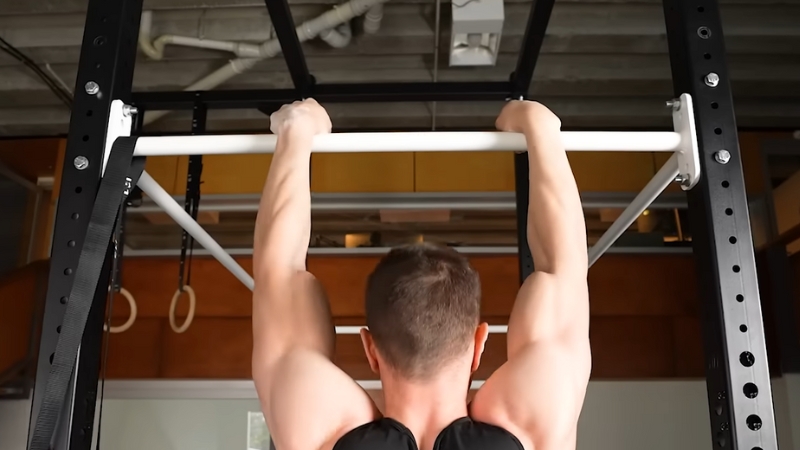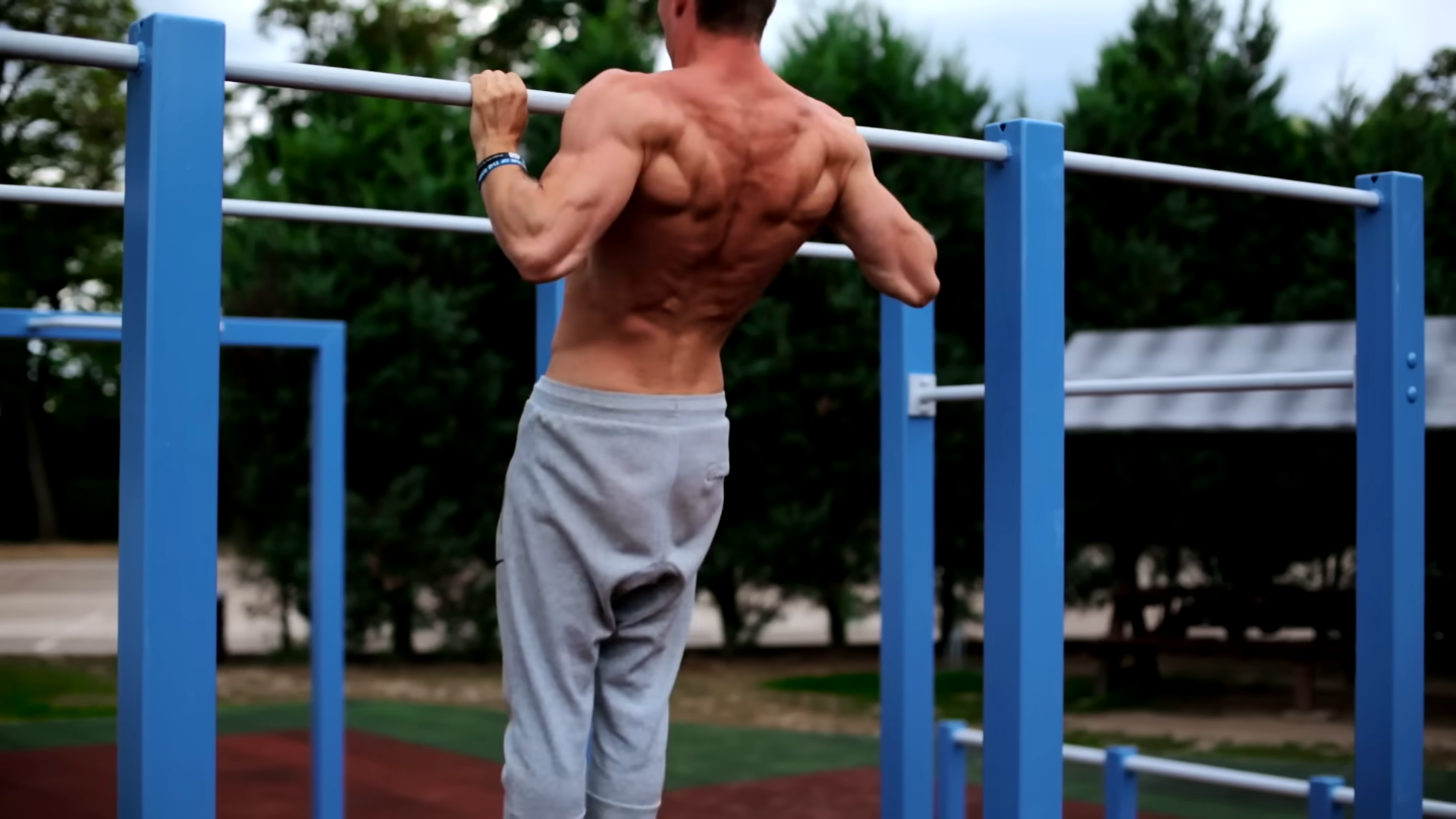Whether you’re new to fitness or an experienced athlete, pull-ups challenge multiple muscle groups simultaneously, leading to faster strength gains and improved overall performance.
From enhancing grip strength to boosting your metabolic rate, this exercise offers a range of physical and mental benefits.
Let’s get into why pull-ups should be a staple in your routine and how they can elevate both your strength and health.
1. Engages Multiple Muscle Groups Simultaneously

Pull-ups are a compound exercise that targets several major muscle groups at once, making them highly efficient for building overall strength.
Muscles Worked
- Latissimus Dorsi (Lats): The primary muscle engaged, responsible for the ‘V’ shape in the back.
- Biceps Brachii: Assists in elbow flexion during the upward movement.
- Rhomboids and Trapezius: Stabilize the shoulder blades.
- Deltoids (Posterior): Support shoulder movement.
- Core Muscles: Engage to stabilize the body.
Medical Perspective
Dr. Brad Schoenfeld, a leading expert in muscle hypertrophy, emphasizes that compound movements like pull-ups stimulate greater muscle growth due to increased hormonal responses, such as elevated testosterone and growth hormone levels.
This anabolic environment promotes muscle protein synthesis across multiple muscle groups.
2. Enhances Grip Strength

Grip strength is crucial for daily activities and other exercises. Pull-ups naturally improve this aspect due to the requirement of hanging and lifting your body weight.
Benefits of Improved Grip
- Functional Strength: Assists in tasks like carrying groceries or opening jars.
- Performance Enhancement: Benefits other lifts such as deadlifts, rows, and snatches.
Strength coach Charles Poliquin highlighted that grip strength correlates with overall muscular strength and endurance.
A strong grip can also reduce the risk of hand and wrist injuries.
3. Improves Posture and Spinal Health
In today’s sedentary lifestyle, poor posture is a common issue. Pull-ups strengthen the back muscles responsible for maintaining proper spinal alignment.
Postural Corrections
- Strengthens Erector Spinae: Supports the spine’s natural curvature.
- Balances Muscle Tension: Alleviates tightness in the chest and anterior shoulder muscles.
Dr. Michael Fredericson from Stanford University notes that exercises targeting the posterior chain, like pull-ups, can correct postural imbalances and reduce the risk of musculoskeletal disorders.
4. Aids in Weight Loss and Increases Metabolic Rate
Four step pull-up progression:
1. Dead hang
2. Hold the top
3. Lower slowly
4. Full repsWork your way down the list. Also: if you’re overweight it helps A LOT to lose some of the weight.
Using something like pull-ups and/or maybe running to encourage a fat loss diet can help…
— Daniel Richter | StrengthLog (@strengthlogapp) September 5, 2024
Pull-ups can boost your metabolism, aiding in fat loss and weight management.
Metabolic Effects
- Increased Muscle Mass: More muscle tissue elevates basal metabolic rate (BMR).
- EPOC Effect: Excess post-exercise oxygen consumption leads to additional calorie burn after workouts.
A study published in the Journal of Applied Physiology found that resistance training exercises like pull-ups significantly increase metabolic rate and fat oxidation.
5. Boosts Core Strength and Stability

Performing pull-ups requires substantial core engagement to stabilize the body, enhancing abdominal and lower back strength.
Core Muscles Involved
- Rectus Abdominis
- Obliques
- Transverse Abdominis
6. Promotes Functional Fitness and Mobility
Pull-ups mimic natural movement patterns, improving functional strength that translates to everyday activities.
Functional Benefits
- Enhanced Pulling Power: Useful in climbing, lifting, and pulling tasks.
- Improved Coordination: Develops neuromuscular connections.
Dr. Stuart McGill, a professor of spine biomechanics, emphasizes that exercises like pull-ups enhance functional movement patterns, reducing the risk of injury during daily activities6.
7. Increases Muscular Endurance

Regularly incorporating pull-ups can enhance your muscles’ ability to perform over extended periods.
Endurance Development
- Type I Muscle Fibers: Pull-ups train slow-twitch fibers responsible for endurance.
- Capillary Density: Increased blood flow improves muscle endurance.
8. Supports Shoulder Joint Health
View this post on Instagram
Pull-ups strengthen the muscles surrounding the shoulder joint, promoting stability and reducing injury risk.
Shoulder Stability
- Strengthens Rotator Cuff Muscles: Supraspinatus, infraspinatus, teres minor, and subscapularis.
- Enhances Proprioception: Improves the body’s ability to sense joint position.
Research in NCBI indicates that strengthening peri-scapular muscles through exercises like pull-ups can prevent shoulder impingement and rotator cuff injuries.
9. Versatile and Adaptable Exercise
Pull-ups can be modified to suit various fitness levels, making them accessible and challenging for everyone.
Modifications
- Assisted Pull-Ups: Use resistance bands or assisted machines.
- Negative Pull-Ups: Focus on the eccentric phase to build strength.
- Weighted Pull-Ups: Add weight for increased difficulty.
Expert Advice
Renowned strength coach Mark Rippetoe advocates for the scalability of pull-ups in progressive overload programs, essential for continuous strength gains.
10. Mental Health and Psychological Benefits
View this post on Instagram
Engaging in pull-ups can have a positive impact on mental well-being, including reducing stress and boosting confidence.
Psychological Advantages
- Endorphin Release: Exercise induces the release of ‘feel-good’ hormones.
- Improved Self-Efficacy: Mastery of challenging exercises enhances confidence.
Scientific Perspective
Dr. John Ratey, a clinical professor of psychiatry at Harvard Medical School, explains that resistance training like pull-ups can alleviate symptoms of depression and anxiety by regulating neurotransmitters.
Incorporating Pull-Ups into Your Fitness Routine

Assessment and Preparation
- Evaluate Your Fitness Level: Start with assisted variations if necessary.
- Warm-Up Properly: Include dynamic stretches targeting the shoulders and back.
Technique Tips
- Grip Width: Standard grip is shoulder-width; variations can target different muscles.
- Full Range of Motion: Extend your arms fully at the bottom and bring your chin over the bar at the top.
- Avoid Kipping: Use controlled movements to maximize muscle engagement.
Progression Strategies
- Increase Repetitions: Gradually add more reps as strength improves.
- Add Variations: Incorporate chin-ups, neutral-grip pull-ups, or commando pull-ups.
- Implement Sets and Rest Periods: Use structured training protocols like 3 sets of 8-12 reps with 1-2 minutes rest.
Safety Considerations

Preventing Injuries
- Listen to Your Body: Stop if you experience pain, especially in the shoulders or elbows.
- Avoid Overtraining: Allow adequate recovery time between sessions.
- Seek Professional Guidance: Consult a fitness professional for personalized advice.
Medical Disclaimer
Always consult with a healthcare provider before starting any new exercise program, especially if you have pre-existing medical conditions or concerns.
Bottom Line
References
- Schoenfeld, B. J. (2010). The mechanisms of muscle hypertrophy and their application to resistance training. Journal of Strength and Conditioning Research, 24(10), 2857-2872. Link
- Fredericson, M., & Moore, T. (2005). Muscular balance, core stability, and injury prevention for middle- and long-distance runners. Physical Medicine and Rehabilitation Clinics, 16(3), 669-689. Link
- Melby, C., Scholl, C., Edwards, G., & Bullough, R. (1993). Effect of acute resistance exercise on postexercise energy expenditure and resting metabolic rate. Journal of Applied Physiology, 75(4), 1847-1853. Link
- McGill, S. M. (2013). Low back disorders: Evidence-based prevention and rehabilitation. Human Kinetics Publishers. Link
- Moezy A, Sepehrifar S, Solaymani Dodaran M. The effects of scapular stabilization based exercise therapy on pain, posture, flexibility and shoulder mobility in patients with shoulder impingement syndrome: a controlled randomized clinical trial. Med J Islam Repub Iran. 2014 Aug 27;28:87. PMID: 25664288; PMCID: PMC4301231. Link
- Ratey, J. J., & Hagerman, E. (2008). Spark: The revolutionary new science of exercise and the brain. Little, Brown and Company. Link

